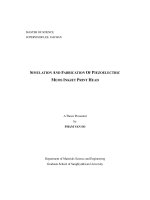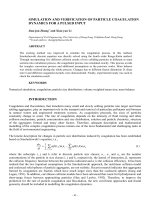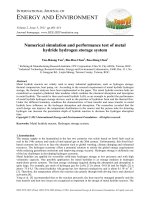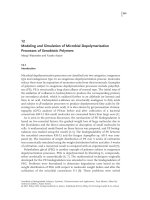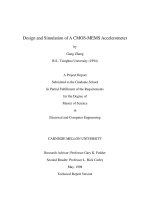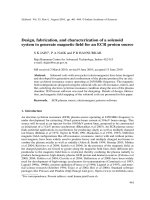Simulation and Fabrication of Piezoelectric mems Inkjet Print head
Bạn đang xem bản rút gọn của tài liệu. Xem và tải ngay bản đầy đủ của tài liệu tại đây (2.77 MB, 66 trang )
MASTER OF SCIENCE
SUPERVISOR LEE. JAICHAN
S
IMULATION
A
ND
F
ABRICATION
O
F
P
IEZOELECTRIC
M
EMS
I
NKJET
P
RINT
H
EAD
A Thesis Presented
by
PHAM VAN SO
Department of Materials Science and Engineering
Graduate School of SungKynKwan University
MASTER OF SCIENCE
SUPERVISOR LEE. JAICHAN
S
IMULATION
A
ND
F
ABRICATION
O
F
P
IEZOELECTRIC
M
EMS
I
NKJET
P
RINT
H
EAD
A Thesis Presented
by
PHAM VAN SO
Submitted to the Graduate School of SungKynKwan University
in partial fulfillment of the requirements for the degree of
MASTER OF SCIENCE
in
Materials Science and Engineering
June 2007
Department of Materials Science and Engineering
Graduate School of SungKynKwan University
i
S
IMULATION
A
ND
F
ABRICATION
O
F
P
IEZOELECTRIC
M
EMS
I
NKJET
P
RINT
H
EAD
by
PHAM VAN SO
A
BSTRACT
Microelectromechanical systems (MEMS) have played an increasingly important
role in sensor and actuator applications. And its key contribution is that it has enabled
the integration of multi-components (i.e., electronics, mechanics, fluidics and etc) on a
single chip and their integration has positive effects upon performance, reliability and
cost. Compared to conventional electrostatic, thermal or magnetic actuating schemes,
piezoelectric MEMS inkjet has the advantages of lower power consumption, lower
voltage operation and relatively larger driving force.
Based on the primary design and fabrication of piezoelectric MEMS inkjet (1
st
version-InkjetVer1) done in our STD Lab, the computer simulation and validation of
inkjet have been investigated, and then the 2
nd
version (InkjetVer2) with the modified
nozzle shape was fabricated and characterized.
In details, firstly the simulation of piezoelectric MEMS inkjet with the electro-
mechanical-fluid interaction has been performed. In order to verify the simulation
results, a fabrication and characterization of actuator part consisting of PZT-based
actuating membrane and ink chamber was carried out. These treatments are to
determine how much “dynamic force”, in terms of membrane’s maximum displacement,
maximum force and driving frequency, can be produced by the actuator membrane.
Secondly, a simulation of microdroplet generation in inkjet has also been done. This
work gives an understanding about the droplet generation process, and the effects of
driving characteristics, fluid properties and geometrical parameters on droplet
generation. Especially, this simulation helps to predict how much “dynamic force” is
required to generate mirodroplets. The combination of both results (i.e., how much
“dynamic force” produced and required) gives an effective guideline in designing inkjet
structure. Thirdly, in the experimental work, the fabrication of InkjetVer2 was carried
out based on MEMS techniques. And then its electrical, mechanical characteristics as
well as possibility of ink ejection were also tested.
Finally, the feedback information from these simulation and experimental work
helps to suggest a new design (3
rd
version - InkjetVer3) which is expected to produce
enough “dynamic force” and possibly generate microdroplets. Then, mask design and
fabrication of InkjetVer3 have also been proceeding.
ii
A
CKNOWLEDGMENTS
First, I would like to thank my supervisors, Prof. Dr. Jaichan Lee and
Assoc.Prof.Dr. Dang Mau Chien for their professional guidance, constructive criticism
and, last but not least, for giving me a good opportunity to study at the Semiconductor
and thin film devices Lab, Department of Materials Science and Engineering,
SungKyunKwan University.
I would also like to thank PhD candidate Sanghun Shin and MSc. Jangkwen Lee
for sharing their knowledge on MEMS processing with me as well as for their useful
discussions.
Furthermore, I would like to thank Prof. Minchan Kim and Dr. Dongwon Lee in
Jeju National University for their generous assistance on my simulation work. And I’m
so grateful to KIST, KITECH and other labs for sharing all the equipments available for
my experimental work.
I would like to thank all STD lab’s members: Dr. Leejun Kim, Dr. Teakjib Choi, Dr.
Juho Kim, MSc. Cho Ju Hyun, MSc. Chul Ho Jung; PhD candidates Phan Bach Thang,
Do Duc Cuong, Ong Phuong Vu and Eui Young Choi; Master candidates Hyun Kyu
Ahn, Jihyun Park, Sukjin Jong and Byun Jun Kang; and lab’s secretaries for their
invaluable help during my MSc course. And my thanks send to my friends in SKKU,
N.T.N. Thuy, N.T. Tien, N.T. Xuyen and N.D.T. Anh, for their helpful discussion and
argument about my results.
Finally, I want to thank my parents and relatives for their constant encouragement
and support.
iii
D
EDICATION
To my parents
Mr. Pham Van Vinh and Mrs. Le Thi Anh
iv
Table of contents
A
BSTRACT
......................................................................................................................... i
A
CKNOWLEDGMENTS
...................................................................................................... ii
Table of contents.............................................................................................................. iv
List of figures .................................................................................................................. vi
List of tables ..................................................................................................................viii
C
HAPTER
1.
I
NTRODUCTION
............................................................................................ 1
1.1 Piezoelectricity ...................................................................................................... 2
1.1.1 Piezoelectric effect ........................................................................................ 2
1.1.2 Lead zirconate titanate (PZT) ......................................................................... 3
1.2 Piezoelectric MEMS inkjet print head................................................................... 5
1.3 Numerical simulation ............................................................................................ 7
1.3.1 Role of numerical simulation ...................................................................... 7
1.3.2 General principle of numerical simulation..................................................... 8
1.3.3 Numerical simulations of piezoelectric MEMS inkjet with CFD-ACE+ ........ 9
1.4 References ........................................................................................................... 10
C
HAPTER
2.
N
UMERICAL
A
ND
E
XPERIMENTAL
S
TUDY
O
N
A
CTUATOR PERFORMANCE
O
F
P
IEZOELECTRIC
M
EMS
I
NKJET
P
RINT
H
EAD
........................................................11
2.1 Introduction ......................................................................................................... 12
2.2 Modeling and simulation settings........................................................................ 13
2.3 Experimental procedure....................................................................................... 16
2.4 Results and discussion......................................................................................... 17
2.4.1 Performance characteristics of PIPH actuator in air................................... 17
2.4.2 Performance characteristics of PIPH actuator in liquid.............................. 18
2.5 Conclusion........................................................................................................... 20
2.6 References ........................................................................................................... 21
C
HAPTER
3.
S
IMULATION
O
F
M
ICRODROP
G
ENERATION
I
N
P
IEZOELETRIC
M
EMS
I
NKJET
P
RINT
H
EAD
...................................................................................................... 26
3.1 Introduction ......................................................................................................... 27
3.2 Modeling and simulation settings........................................................................ 27
v
3.3 Results and discussion......................................................................................... 29
3.3.1 Microdrop generation process....................................................................... 29
3.3.2 Effect of actuating characteristics ................................................................. 29
3.3.3 Effect of fluid properties ............................................................................... 30
3.3.4 Effect of geometrical parameters .................................................................. 32
3.4. Conclusion.......................................................................................................... 32
3.5 References ........................................................................................................... 34
C
HAPTER
4.
F
ABRICATION
A
ND
C
HARACTERIZATION
O
F
P
IEZOELECTRIC
M
EMS
I
NKJET
P
RINT
H
EAD
...................................................................................................... 38
4.1 Introduction ......................................................................................................... 39
4.2 Experiments......................................................................................................... 39
4.3 Results and discussion......................................................................................... 41
4.4 Conclusion........................................................................................................... 42
4.5 Rerefences ........................................................................................................... 44
C
HAPTER
5.
C
ONCLUSION
A
ND
S
UGGESTION
............................................................... 50
5.1 Conclusion........................................................................................................... 50
5.2 Suggestion (new design)...................................................................................... 50
Appendix A. Python Source Script for simulation of microdroplet generation (effects of
driving characteristics and fluid properties)................................................................... 52
Appendix B. Pattern conditions for fabrication of Inkjetver2 ....................................... 54
Appendix C. Dry etching conditions............................................................................. 55
vi
List of figures
Fig.1-1. Direct piezoelectric effect in open circuit (a) and in shorted circuit (b)............. 2
Fig. 1-2. Converse piezoelectric effect: (a) free displacement and blocking force and (b)
static and dynamic operation............................................................................. 3
Fig. 1-3. Structure of PZT unit cell: (a) Cubic (T≥T
c
) an (b) tetragonal (T< T
c
)............. 4
Fig. 1-4. Phase diagram for the PbZrO
3
-PbTiO
3
system. C: Cubic, T: Tetragonal, R
I
:
Rhombohedral (high temp form), R
II
: Rhombohedral (low temp form), A:
rthorhombic, M: MPB, and T
c:
Curie temperature............................................ 4
Fig. 1-5. Deformation mode of piezoelectric inkjet actuator: (a) squeeze, (b) bend, (c)
push and (d) shear mode.................................................................................... 6
Fig. 1-6. A typical approach to MEMS application from concept to devices................... 7
Fig. 1-7. Steps of overall solution procedure.................................................................... 8
Fig. 1-8. Modeling settings for design of piezoelectric MEMS inkjet. Computations are
performed using CFD-ACE+ package software. .............................................. 9
Fig. 2-1. Model of a piezoelectric inkjet print head (PIPH) structure: (a)
design and (b) CFD-ACE+ symmetric model with meshing grids................. 23
Fig. 2-2. Flowchart of fabrication process (a) and SEM images (b) of PIPH actuator... 23
Fig. 2-3. Maximum displacement of PIPH actuator membrane (300 um): (a) simulation
and (b) experiment. Simulation was extended with membrane width of 500-
600 um............................................................................................................. 24
Fig. 2-4. Dependence of actuator performance on geometrical parameters: (a) maximum
displacement vs. thickness ratio (PZT/support layer) and (b) maximum force
(F
max
) and maximum displacement (δ
max
) vs. membrane width...................... 24
Fig. 2-5. Resonance frequency (in air) of PIPH actuator membrane: (a) FEMLAB
simulation and (b) experiment with HP4194A impedance analyzer............... 24
Fig. 2-6. Deflection shape of actuator membrane interacting with liquid: (a) & (b) dome
shape with one peak at low frequencies and (c) & (d) unexpected shape with
more than one peak at higher frequencies (above 125 kHz < 379 kHz -
resonance frequency in air ). ........................................................................... 25
Fig. 2-7. Resonance frequency (in liquid) of PIPH actuator membrane: (a) simulation
and (b) experiment. ......................................................................................... 25
vii
Fig. 3-1. Inkjet head geometry, (a) Three dimensional (3D) and (b) 2D symmetric
section in CFD-ACE+..................................................................................... 35
Fig. 3-2. Microdrop generation process at driving displacement with amplitude of 5 μm
and frequency of 30 kHz. ................................................................................ 35
Fig. 3-3. Droplet properties: no-droplet, single droplet and satellite droplets at various
driving displacements (2~5um, 50 kHz)......................................................... 36
Fig. 3-4. Time duration for droplet generation at various actuating characteristics: (a)
amplitude and (b) frequency. Droplets are generated in one cycle or several
cycles............................................................................................................... 36
Fig. 3-5. Time duration for droplet generation with fluid properties: (a) surface tension
and (b) viscosity. High surface tension or viscosity makes cohesive forces
predominant..................................................................................................... 36
Fig. 3-6. Geometrical parameters: (a) relative chamber X1/X2, (b) aspect ratio d/h and
(c) diffuser. ...................................................................................................... 37
Fig. 3-7. Time duration for droplet generation vs.: (a) relative chamber size (A-type) and
(b) aspect ratio (B-type & C-type). ................................................................. 37
Fig. 3-8. Time duration for droplet generation vs. driving characteristics of the selected
structure (B-type). Microdroplet can be generated at an applied voltage of 9V-
21V and frequency above 15 kHz................................................................... 37
Fig. 4-1. Schematic of piezoelectric inkjet print head structure (side view): (a) Inkjet
version 1 and (b) Inkjet version 2 with the modified nozzle shape at locations
marked 1 &2.................................................................................................... 45
Fig. 4-2. Masks used for fabrication of PIPH : M1-M6 (wafer 1) and M7- M10 (wafer2).
......................................................................................................................... 45
Fig.4-3. Fabrication process flow of PIPH: (a) wafer 1-actuator and chamber and (b)
wafer 2-channel and nozzle. Both wafers are bonded by Eutectic bonding
method............................................................................................................. 46
Fig. 4-4. SEM and optical micrographs of the fabricated PIPH structure...................... 47
Fig. 4-5. Preparing for ejection test: (a) 4-inkjet heads on 1 cell and (b) PCB-wire
bonding and tube attachment........................................................................... 48
Fig. 4-6. Ejection testing by high speed digital camera system. .................................... 49
Fig. 4-7. Meniscus vibration under an applied voltage of 10V-40 kHz. ........................ 49
Fig. 5-1. Model of InkjetVer3 (3-silicon wafers)........................................................... 51
Fig. 5-2. Masks used for fabrication of InkjetVer3........................................................ 51
viii
List of tables
Table 2-1. Fluid properties............................................................................................. 22
Table 2-2. Support layer properties ............................................................................... 22
Table 2-3. PZT properties (PZT 52/48 )......................................................................... 22
Table 2-4. The displacement at various driving frequencies (voltage=5V)................... 22
Table 2-5. Summary of actuator performance characteristics....................................... 22
1
C
HAPTER
1.
I
NTRODUCTION
I
NKJET
printing is familiar as a method for printing computer data onto paper or
transparencies as well as industrially printing information on cans or bottles. Recently
it has been used as free-form fabrication method for building three dimensional parts
(maskless fabrication) and is also being used to produce arrays of proteins and nucleic
acids.
The objective of this thesis is to investigate the piezoelectric MEMS inkjet print
head from design to fabrication. Therefore, this chapter will briefly summarize the
background of piezoelectricity, types of piezoelectric MEMS inkjet head and general
principle of numerical simulation.
2
1.1 Piezoelectricity
1.1.1 Piezoelectric effect
All polar crystals show piezoelectricity, since any mechanical stress T will result in
strain because of the elastic properties of the materials. And the strain will affect the
polarization since the polarization is caused by a displacement of the charge centers of
the anions and cations. For small changes of the stress T, the relation
P=d.T
is called the direct piezoelectric effect, where d denotes the piezoelectric coefficient.
Once a force (mechanical stress) is applied to a piezoelectric material, surface charge is
induced by the dielectric displacement and therefore an electric field is built up. On
applied electrodes this field can be tapped as electrical voltage (Fig. 1-1. (a)). If the
electrodes are shorted, the surface charge balances out by a current ((Fig. 1-1. (b)). The
direct piezoelectric effect is employed for mechanical sensors.
Fig.1-1. Direct piezoelectric effect in open circuit (a) and in shorted circuit (b).
Because of the piezoelectric property of polar materials, a converse effect is
observed. If an external electrical field, E is applied, a strain
S=d.E
is observed. If this strain is prevented (blocking totally or partially the material), an
elastic tension T occurs. A force F is thereby applied to the device, which prevent to the
distortion of the piezoelectric body (Fig. 1-2.(a)). In practice, the converse piezoelectric
effect is used in static as well as dynamic operation (Fig. 1-2. (b)) and it is used for
3
mechanical actuators. The first experimental work on piezoelectricity was performed by
Pierre and Jacques Curie in 1880.
Fig. 1-2. Converse piezoelectric effect: (a) free displacement and blocking force and (b)
static and dynamic operation.
The piezoelectric effect is exhibited by a number of naturally and synthetically
single crystals under two different behaviors. Materials such as quartz exhibited a zero
polarization when the external electric or mechanical field is removed. Other single
crystal materials such as Rochelle salt, barium titanate, and others show a remanent
polarization without external stress. Moreover, the direction of the polarization could be
reversed by application of an inverse electric field. In this case, a hysteresis field
appears and the material is called ferroelectric. The origin of the piezoelectric effect in
both types of crystal is common and related to an asymmetry in the cell unit and the
resultant generation of electric dipoles due to the mechanical distortion leading to a net
polarization at the crystal surface [2,3].
1.1.2 Lead zirconate titanate (PZT)
Lead zirconate titanate (PZT) is a kind of perovskite oxide which has a stably cubic
structure at temperature above its Curie temperature (T
c
) as seen in Fig. 1-3(a). When
the temperature decreases and falls below T
c
the structure changes. The O
2-
and the Pb
2+
ions are moved from their cubic positions and the Ti
4+
and Zr
4+
ions are moved from the
center of the cube (Fig.1-3(b)). This results in a dipole and a structure that is no longer
cubic but rather than tetragonal.
The significant feature of PZT is its phase diagram, which is characterized by a
4
boundary, known as the morphotropic phase boundary (MPB, i.e. the boundary between
rhombohedral and tetragonal phases at PbZr
0.52
Ti
0.48
O
3
). Figure 1-4 shows the phase
diagram for the PbZrO
3
-PbTiO
3
system. PZT compositions were developed for
moderate power applications. PZT compositions have a low loss tangent resulting in
low power losses as well as high distortion constant and high Curie point. Compositions
near MPB have the largest piezoelectric constants and dielectric constants. This
enhancement is a result of enhanced polarizability arising from the coupling between
two equivalent energy states, i.e. the tetragonal and rhombohedral phases, allowing
optimum domain reorientation during the poling process. In other word, it is due to the
greater ease of polarization near MPB.
Fig. 1-3. Structure of PZT unit cell: (a) Cubic (T≥T
c
) an (b) tetragonal (T< T
c
).
Fig. 1-4. Phase diagram for the PbZrO
3
-PbTiO
3
system. C: Cubic, T: Tetragonal, R
I
:
Rhombohedral (high temp form), R
II
: Rhombohedral (low temp form), A: rthorhombic,
M: MPB, and T
c:
Curie temperature.
5
Among the important material parameters, electromechanical coupling, dielectric
constant, and associated piezoelectric coefficient are the key parameters to be
compositionally engineered. In general, the piezoelectric properties of a ferroelectric
ceramic can be expressed using the simplistic term,
d
ij
~ 2 kε
o
Q
ij
P
i
where d
ij
is the piezoelectric coefficient, P
i
the remnant polarization on poling, k the
dielectric constant, Q
ij
the electrostriction coefficient. Since both Q
ij
and P
i
exhibit little
dependence on composition at temperature below T
c
in ferroelectric ceramics such as
PZT, the d
ij
and k are interrelated, i.e. a ceramic with high piezoelectric coefficient also
exhibits a large dielectric constant. To achieve a high dielectric constant or piezoelectric
coefficient, MPB based ceramics can be further engineered by compositionally
adjusting the T
c
downward relative low temperatures. The lower the T
c
, the higher the
dielectric constant is [4,5].
PZT is one of extremely important materials in mechatronics and MEMS
applications. In its bulk form, PZT is not readily amenable for integration into silicon
micro-mechanical devices. However PZT thin films are extremely promising as electro-
mechanical elements for use with micro-mechanical structures. PZT is a polar dielectric,
which exhibits a high degree of piezoelectric activity. PZT can be deposited by a
number of processing routes onto silicon devices. The most common deposition
methods are sputtering, sol-gel, metalorganic chemical vapor deposition (MOCVD) and
laser ablation [6]. In this research, PbZr
0.52
Ti
0.48
O
3
thin film which is a main component
of actuator membrane of piezoelectric MEMS inkjet print head was formed by spin
coating its sol-gel solution.
1.2 Piezoelectric MEMS inkjet print head
Piezoelectric actuators convert electrical signals (i.e., voltage, charges) into
mechanical displacements or force. Depending on the deformation mode of the
piezoelectric material, the piezoelectric inkjet technology can be classified into four
main types: squeeze, bend, push, and shear (as shown in Fig. 1-5). For squeeze mode,
radially polarized ceramic tubes are used. In both bend- and push-mode design, the
6
electric field is generated between the electrodes parallel to the polarization of the
piezo-material. In a shear mode printhead, the electric field is designed to be
perpendicular to the polarization of the piezoceramics [4]. All of them have the same
principle of droplet generation that the deformation of piezoelectric actuator under
applied voltage leads to change of volume, causes the destabilization of the ink liquid
and generates the droplets if the competition between cohesive and descriptive forces
occurs favorably.
Fig. 1-5. Deformation mode of piezoelectric inkjet actuator: (a) squeeze, (b) bend, (c)
push and (d) shear mode.
Piezoelectric MEMS inkjet structures used the piezoelectric thin film as main
component of actuator part which has forcing function, and were integrated fluidic
components such as ink chamber, channel and ink reservoir. In the case of inkjet heads,
print resolution is one of the primary measures of product performance. When printing
with inkjet heads, smaller, more tightly spaced droplets of ink result in sharper print
quality. However, this produces a smaller print area, resulting in an increased printing
time. To optimize both print quality and speed, a printer head must deliver an increased
number of smaller-sized droplets, droplets; this equates directly to an increase in the
density of holes per inch in an inkjet head [7]. Therefore, the contribution of MEMS
technology in fabricating inkjet heads is not only an integration of multi-components as
well as their micro-scales but also an increase of numerous nozzles or array of nozzles
(based on deep reactive ion etching (DRIE) technique).
7
1.3 Numerical simulation
1.3.1 Role of numerical simulation
A typical approach to MEMS application from concept to devices can be shown in
Fig. 1-6. The approach consists of several steps such as specifications of MEMS device,
design, modeling to evaluate performance, fabrication and testing. Reviews of the
modeling and test results enable optimization of the performance of the MEMS device.
Fig. 1-6. A typical approach to MEMS application from concept to devices.
The process of developing a MEMS application starts with determining the
specifications for MEMS device (i.e., inkjet print head). The specifications come from
the nature of physical phenomenon, mechanism of operating principle and etc. With the
specifications in place, the next step is design which is the most important step in the
flow sheet from concept to prototype. Depending on the complexity of the design, it’s
often difficult to predict the performance of MEMS devices intuitively. In these cases
computer simulations may provide a means to study the performance of MEMS devices
prior to fabrication. Behavior individual components as well as integrated components
of the entire device can be predicted by computer simulations. By including the review
step after simulation, structures can be optimized their geometrical parameters before
fabricating the components or devices. Computer simulations can significantly shorten
the possibly long process of MEMS design, fabrication and testing. Not only can they
8
provide a more complete understanding of the physical phenomenon but they can also
be used to develop optimal designs and to minimize the risk of wasting expensive
production time on a flawed design [8-10].
1.3.2 General principle of numerical simulation
Physical phenomena are generally described by mathematical equations, typically
partial differential equations (for example: Navier-Stokes equations are used to
characterize the fluid flows). Analytical solutions of partial differential equations
involve close-form expressions which give the variation of the dependent variables
continuously throughout the domain. In contrast, numerical solutions can give answers
at only discrete points in the domain, called grid points. Numerical methods become
more effective with the aid of computer. The numerical solution procedure consists of
discretization process (discreting partial differential equations into a system of algebraic
equations) and solution process (using iterative methods to get the approximate results)
(Fig.1-7). The discretization includes space discretization or grid generation and
equation discretization. There are three basic grids such as structured grids, unstructured
grids and hybrid/mixed grids. Equation discretization can be done by boundary methods
or domain methods such as finite difference method (FDM), finite volume method
(FVM) and finite element method (FEM). So far, there have been a lot of commercial
softwares developed based on these methods such as ANSYS, FEMLAB. Intellisuite,
CFD-ACE+, etc…
Fig. 1-7. Steps of overall solution procedure.
9
1.3.3 Numerical simulations of piezoelectric MEMS inkjet with CFD-ACE+
Piezoelectric MEMS inkjet print head is a complex device integrated electro-
mechanical-fluidic components. The modeling, therefore, was performed in a separated
way consisting of simulating (1) actuator performance and (2) droplet generation. The
former concentrates on analyzing the piezoelectric actuator characteristics (i.e., driving
force, displacement and frequency) with electro-mechanical-fluidic couplings. The fluid
flow is driven by the vibration of the thin plate and the flow also imposes a resistance to
this vibration. Thus, vibrations of the plate and the fluid flow are inherently coupled.
The vibration characteristics of actuator membrane of piezoelectric MEMS inkjet head
highly depend on this fluid-structure coupling. Therefore, fluid-structure interaction is
one of the primary concerns when studying piezoelectric inkjet head. The later
considers the generation of microdroplets which is influenced by a strong competition
between cohesive and disruptive forces (i.e., driving force, viscous force and surface
tension force). The simulations have been performed by CFD-ACE+ package software
known as a multiphysics modeling tool. The details of simulation settings will be
described in chapter 2 and chapter 3. The goals of these simulations are indicated in Fig.
1-8.
Fig. 1-8. Modeling settings for design of piezoelectric MEMS inkjet. Computations are
performed using CFD-ACE+ package software.
10
1.4 References
[1] Paul Calvert, Inkjet printing for materials and devices, Chem.Mater.2001,13, 3299-
3305.
[2] Rainer Waser, Nanoelectronics and Information Technology, Volume.1, Advanced
Electronic Materials and Novel Devices, WILEY-VCH,2003.
[3] Alfredo Vázquez Carazo, Novel Piezoelectric Transducers for High Voltage
Measurements, Ph.D. Thesis, 2000.
[4] Jürgen Brünahl, Physics of Piezoelectric Shear Mode Inkjet Actuators, Universitets
service US AB, Stockholm 2003.
[5] Seung-Eek Park and Thomas R. Shrout, Characteristics of Relaxor-Based
Piezoelectric Single Crystals for Ultrasonic Transducers, IEEE TRANSACTIONS ON
ULTRASONICS, FERROELECTRICS, AND FREQUENCY CONTROL, VOL. 44,
NO. 5, SEPTEMBER 1997.
[6] D.F.L. JENKINS, W.W. CLEGG, E. CATTAN & D. REMIENS, PZT Thin Film Bi-
Layer Devices for Phase Controlled Actuation in MEMS, Journal of Electroceramics, 7,
5–11, 2001.
[7] Janet Hopkins, DRIE of Silicon for MEMS Inkjet Heads, Surface Technology
Systems Ltd., Newport, UK-11/1/2004, Semiconductor International.
[8] Xiaopeng Zhao, Modeling and Simulation of MEMS Devices, PhD dissertation,
Blacksburg, Virginia, 2004.
[9] Oliver Geschke, Henning Klank, Pieter Telleman, Microsystem Engineering of Lab-
on-a-chip Devices, WILEY-VCH Verlag GmbH & Co. KGaA, 2004.
[10] CFD-ACE+ Modules Manual version 2004.
11
C
HAPTER
2.
N
UMERICAL
A
ND
E
XPERIMENTAL
S
TUDY
O
N
A
CTUATOR PERFORMANCE
O
F
P
IEZOELECTRIC
M
EMS
I
NKJET
P
RINT
H
EAD
Abstract
In this study, we focused on considering the actuator performance of a
piezoelectrically actuated inkjet print head with the numerical and experimental
analysis. The actuator part consisting of multi-layer membranes, such as piezoelectric,
elastic and other buffer layers, and ink chamber was fabricated by MEMS processing.
The maximum displacement of the actuator membrane obtained from the simulation and
experiment was ca. 0.053 um/V and 0.059 um/V, respectively. As a result of fluidic
damping, both simulation and experimental results show the resonant frequency of
membrane in liquid is ca.3 times smaller than its resonant frequency in air. These
simulation and experimental studies play an important role to predict how much
“dynamic force”, in terms of membrane’s maximum displacement, maximum force and
driving frequency, can be produced by a certain actuator membrane interacting with
fluid.
12
2.1 Introduction
MEMS technology is inherently multidisciplinary, which has resulted in synergies
between previously unrelated fields, such as fluidics and microelectronics. For example,
piezoelectric MEMS inkjet print head, one of the most important elements in an ink-jet
printing system, is a combination of microfluidics and microfabrication (MEMS) and is
used to eject small amounts of fluid on target surfaces. Compared to conventional
electrostatic, thermal or magnetic actuating schemes, piezoelectric MEMS inkjet has the
advantages of lower power consumption, lower voltage operation and relatively larger
driving force. In addition, Piezoelectric inkjet print heads normally offer a greater range
of ink compatibility than thermal ink-jet heads, which are limited to water-based inks or
require a new design for each different type of ink solvent [1-7].
Various designs and fabrication techniques of piezoelectric inkjet print head (PIPH)
have been reported in the literatures [4-7]. In this study, we designed a PIPH structure
which could be fabricated from two silicon wafers using MEMS processing. However,
depending on the complexity of PIPH structure integrating actuator-chamber-reservoir
components, it’s difficult to predict the performances of inkjet intuitively. One of
important parts of a PIPH is actuator component which exhibits the ability of PIPH to
work and eject the ink droplets. Therefore, a numerical simulation of PIPH to analyze
its actuator performance has been performed prior to fabrication. In order to verify
simulation results, a fabrication of PIPH’s actuator component was also carried out
before the whole PIPH structure was fabricated. In addition, this treatment helps to
understand physical phenomena in interaction between solid and fluid components such
as piezoelectric actuator and ink chamber. Fan et al revised that no complete coupling
study would lead to that the flow rate increased continuously with increasing the
frequency even at extremely high frequencies [4]. Therefore, structural-fluidic
interaction is one of primary concerns when studying actuator performance of inkjet
head structure. In simulation work, the finite element method (FEM) and computational
fluid dynamics (CFD) with finite volume method (FVM) are employed to study the
membrane-fluid coupling. In experimental work, the piezoelectric actuator component
13
was fabricated using MEMS processing. Then, its characteristics including
displacement and resonance frequency were also monitored using a LK-G10-
KEYENCE non-contact laser displacement measurement and a HP4194A impedance
analyzer, respectively. This paper addresses how the maximum displacement, maximum
force and driving frequency affect to the PIPH actuator performance. Simulation results
in air and in liquid agree well with experimental ones.
2.2 Modeling and simulation settings
The inkjet structure consists of an ink chamber connected directly with a nozzle and
a reservoir. This chamber is covered by a multi-layer membrane which consists of a
primary piezoelectric actuator layer (PZT) and other secondary layers including an
elastic layer (SiN
x
) and several buffer layers, i.e., SiO
2
, Ta/Pt. Total thickness of
secondary layers is 2.3 um. In simulation, all secondary layers are modeled by an
equivalent layer (called support layer) with effective parameters calculated by ROM
(rule of mixtures) model [8]. Therefore, the model of PIPH actuator is a bi-layer
membrane (called actuator membrane) including PZT film and support layer. The
relative size (ratio of lateral dimensions) of PZT layer and support layer is 0.8 [our
previous report, 9]. In order to reduce the backflow from chamber to reservoir but still
maintain good recovery of flow from reservoir to chamber, a diffuser is used as an
active connector between them. The selection of geometrical parameters of diffuser
such as divergence angle, aspect ratio and etc is based on standardized data [10]. With
this model of PIPH, the fluid flow is driven by the vibration of the actuator membrane
and the flow also imposes a resistance to this vibration. Thus, the vibration of actuator
membrane and the fluid flow are inherently coupled. The actuator performance
characteristics of PIPH highly depend on this fluid-structure coupling. The model of
PIPH structure is shown in Fig. 2-1.
For the simulation of PIPH structure, some governing equations on both the fluid
side and the solid structure side are needed. The governing equations on the fluid side
are the Navier-Stokes equation and the mass continuity equation, while the governing
equations on the solid structure side are equations for the actuation of piezoelectric
14
actuator and the motion of the elastic membrane.
Because the characteristic length of the PIPH is in micro scale (10
-6
) and the
Reynolds number is very low, the flow can be assumed as an incompressible laminar
flow. Therefore, the Navier-Stokes equations and the mass continuity equation become
[11]
PVg
Dt
VD
LL
∇−∇+=
r
r
r
2
μρρ
(1)
0).( =∇+
∂
∂
L
L
V
t
ρ
ρ
r
(2)
where
),,( wvuV =
r
is velocity vector, ρ
L
is density of liquid, μ is viscosity of liquid.
The properties of the fluid are listed in Table 2-1.
Boundary conditions for the fluid model are non-slip at the fluid-wall interfaces (
0=V
r
)
and free at the outlet/inlet.
Boundary condition at the membrane-fluid interface is given by
t
W
w
erfacefm
∂
∂
=
− int
(3)
The coupled electro-mechanical constitutive equation for piezoelectric actuators is [12]
kijkkl
E
ijklij
EdSCT −=
(4)
where T
ij
is mechanical stress tensor, S
kl
is mechanical strain tensor, d
ijk
is piezoelectric
constant tensor, C
E
ijkl
is elastic stiffness constant tensor at constant electric field . C
E
ijkl
is a 6x6 symmetric tensor.
Piezoelectric material used in simulation and fabrication is PZT with ratio
Zr:Ti=0.52:0.48. Its properties are listed in Table 2-2.
According to the elastic plate theory [13], the equation of displacement of
membranes is given by
